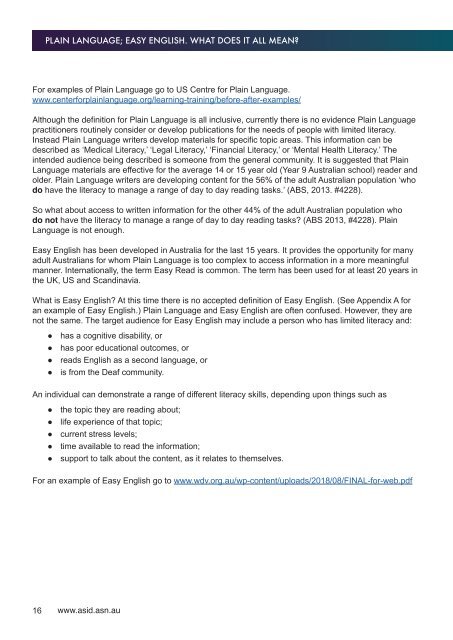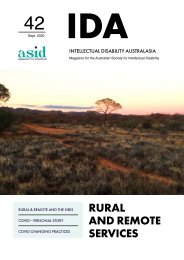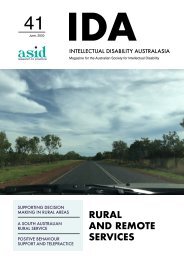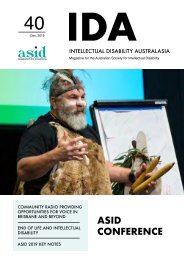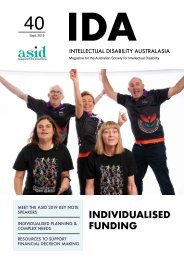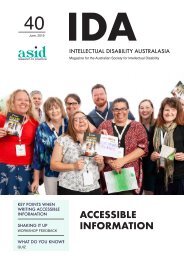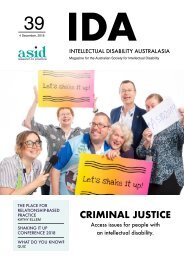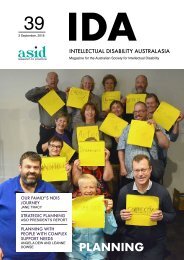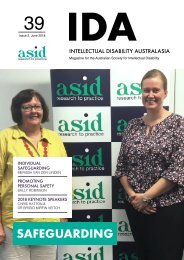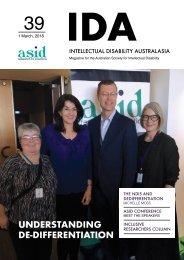IDA Magazine Vol 40 Iss 2 (June 2019)
You also want an ePaper? Increase the reach of your titles
YUMPU automatically turns print PDFs into web optimized ePapers that Google loves.
PLAIN LANGUAGE; EASY ENGLISH. WHAT DOES IT ALL MEAN?<br />
For examples of Plain Language go to US Centre for Plain Language.<br />
www.centerforplainlanguage.org/learning-training/before-after-examples/<br />
Although the definition for Plain Language is all inclusive, currently there is no evidence Plain Language<br />
practitioners routinely consider or develop publications for the needs of people with limited literacy.<br />
Instead Plain Language writers develop materials for specific topic areas. This information can be<br />
described as ‘Medical Literacy,’ ‘Legal Literacy,’ ‘Financial Literacy,’ or ‘Mental Health Literacy.’ The<br />
intended audience being described is someone from the general community. It is suggested that Plain<br />
Language materials are effective for the average 14 or 15 year old (Year 9 Australian school) reader and<br />
older. Plain Language writers are developing content for the 56% of the adult Australian population ‘who<br />
do have the literacy to manage a range of day to day reading tasks.’ (ABS, 2013. #4228).<br />
So what about access to written information for the other 44% of the adult Australian population who<br />
do not have the literacy to manage a range of day to day reading tasks? (ABS 2013, #4228). Plain<br />
Language is not enough.<br />
Easy English has been developed in Australia for the last 15 years. It provides the opportunity for many<br />
adult Australians for whom Plain Language is too complex to access information in a more meaningful<br />
manner. Internationally, the term Easy Read is common. The term has been used for at least 20 years in<br />
the UK, US and Scandinavia.<br />
What is Easy English? At this time there is no accepted definition of Easy English. (See Appendix A for<br />
an example of Easy English.) Plain Language and Easy English are often confused. However, they are<br />
not the same. The target audience for Easy English may include a person who has limited literacy and:<br />
● ● has a cognitive disability, or<br />
● ● has poor educational outcomes, or<br />
● ● reads English as a second language, or<br />
● ● is from the Deaf community.<br />
An individual can demonstrate a range of different literacy skills, depending upon things such as<br />
● ● the topic they are reading about;<br />
● ● life experience of that topic;<br />
● ● current stress levels;<br />
● ● time available to read the information;<br />
● ● support to talk about the content, as it relates to themselves.<br />
For an example of Easy English go to www.wdv.org.au/wp-content/uploads/2018/08/FINAL-for-web.pdf<br />
16 www.asid.asn.au


